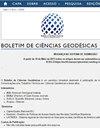Use of GNSS and a refined GGM (XGM2019e) for determining normal heights in the Imbituba Brazilian Vertical Datum and in the International Height Reference System
IF 0.5
Q3 Earth and Planetary Sciences
引用次数: 1
Abstract
: This paper aimed to evaluate the use of Global Navigation Satellite System (GNSS) ellipsoidal heights in conjunction with height anomalies provided by Global Geopotential Model (GGM) XGM2019e, refined by Residual Terrain Modelling (RTM) technique, to obtain normal heights in Brazil, referred to the Imbituba Brazilian Vertical Datum (IBVD) and the International Height Reference System (IHRS). For this purpose, a local modelling approach has been analyzed in contrast to the national modeling one on the reference geopotential value. For this, a methodology based on geopotential space was adapted. In the local modeling, two study subregions were defined using the spatial clustering analysis of IBVD and GGM/RTM height anomalies differences outliers. The parameters have been estimated using three different configurations. In the parameters validation step, Root Mean Square Errors (RMSE) of the discrepancies between transformed and Brazilian official normal heights were calculated. In both subregions more accurate results have been obtained with the local modeling. In the SP1 subregion the accuracy increased tenfold (0.97m to 0.10m) and SP2 improved from 0.39m to 0.17m. For the linkage to the future realization of IHRS, the accuracy analysis was not possible. However, discrepancies between calculated normal heights and Brazilian official normal heights have been analyzed.使用GNSS和改进的GGM (XGM2019e)来确定Imbituba巴西垂直基准面和国际高度参考系统的正常高度
基于Imbituba巴西垂直基准面(IBVD)和国际高度参考系统(IHRS),利用全球导航卫星系统(GNSS)椭球面高度,结合全球地势模型(GGM) XGM2019e提供的高度异常,通过残差地形建模(RTM)技术进行细化,评估巴西正常高度的使用情况。为此,分析了一种局部模拟方法,并与参考地势值的国家模拟方法进行了对比。为此,采用了一种基于位势空间的方法。在局部模型中,利用IBVD和GGM/RTM高度异常差异异常值的空间聚类分析,定义了两个研究子区域。使用三种不同的配置对参数进行了估计。在参数验证步骤中,计算了转换后的高度与巴西官方正态高度之间差异的均方根误差(RMSE)。在这两个子区域,采用局部模拟得到了更精确的结果。SP1子区域的精度提高了10倍(0.97m提高到0.1 m), SP2子区域的精度从0.39m提高到0.17m。为了与未来IHRS的实现联系,不可能进行准确性分析。然而,计算出的正常身高与巴西官方的正常身高之间的差异已被分析。
本文章由计算机程序翻译,如有差异,请以英文原文为准。
求助全文
约1分钟内获得全文
求助全文
来源期刊

Boletim De Ciencias Geodesicas
Earth and Planetary Sciences-General Earth and Planetary Sciences
CiteScore
1.70
自引率
20.00%
发文量
10
审稿时长
3 months
期刊介绍:
The Boletim de Ciências Geodésicas publishes original papers in the area of Geodetic Sciences and correlated ones (Geodesy, Photogrammetry and Remote Sensing, Cartography and Geographic Information Systems).
Submitted articles must be unpublished, and should not be under consideration for publication in any other journal. Previous publication of the paper in conference proceedings would not violate the originality requirements. Articles must be written preferably in English language.
 求助内容:
求助内容: 应助结果提醒方式:
应助结果提醒方式:


